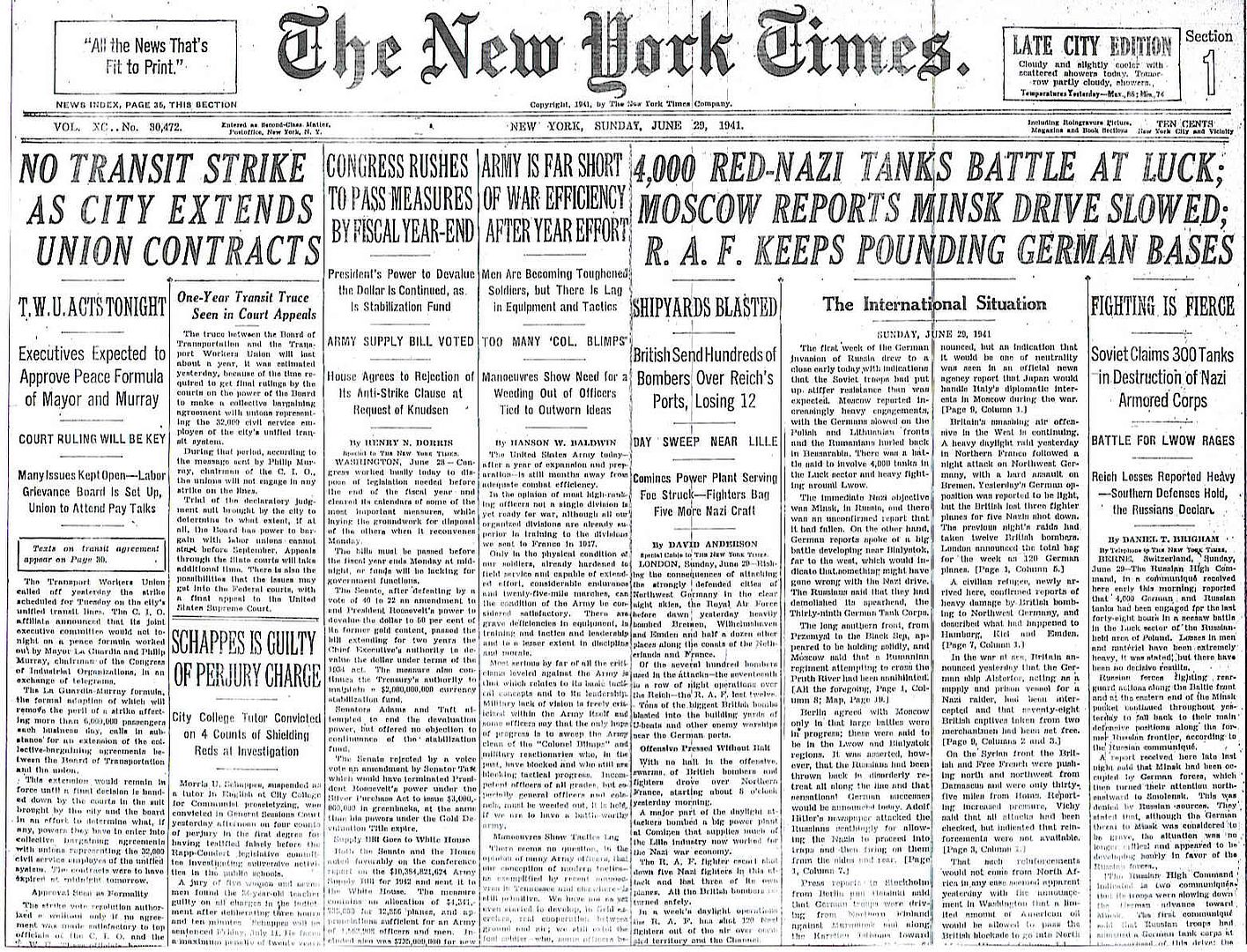
Posted on 06/29/2011 4:39:27 AM PDT by Homer_J_Simpson

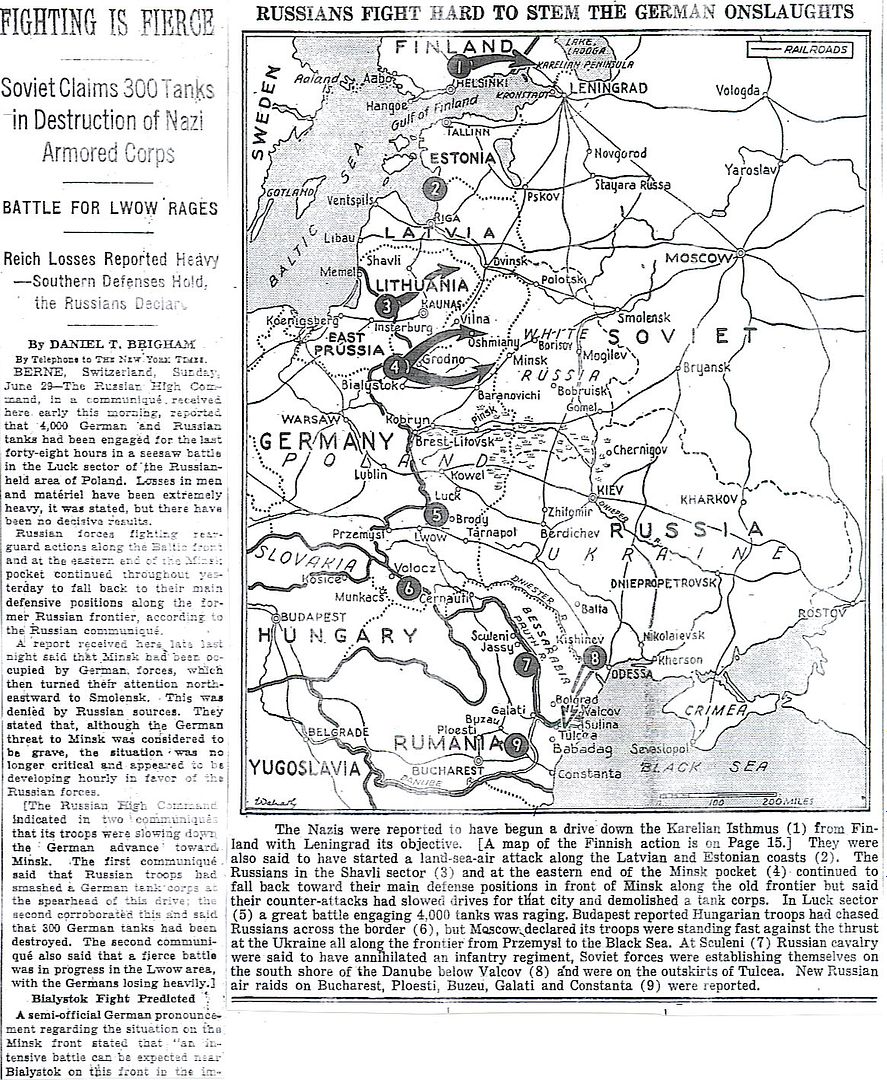
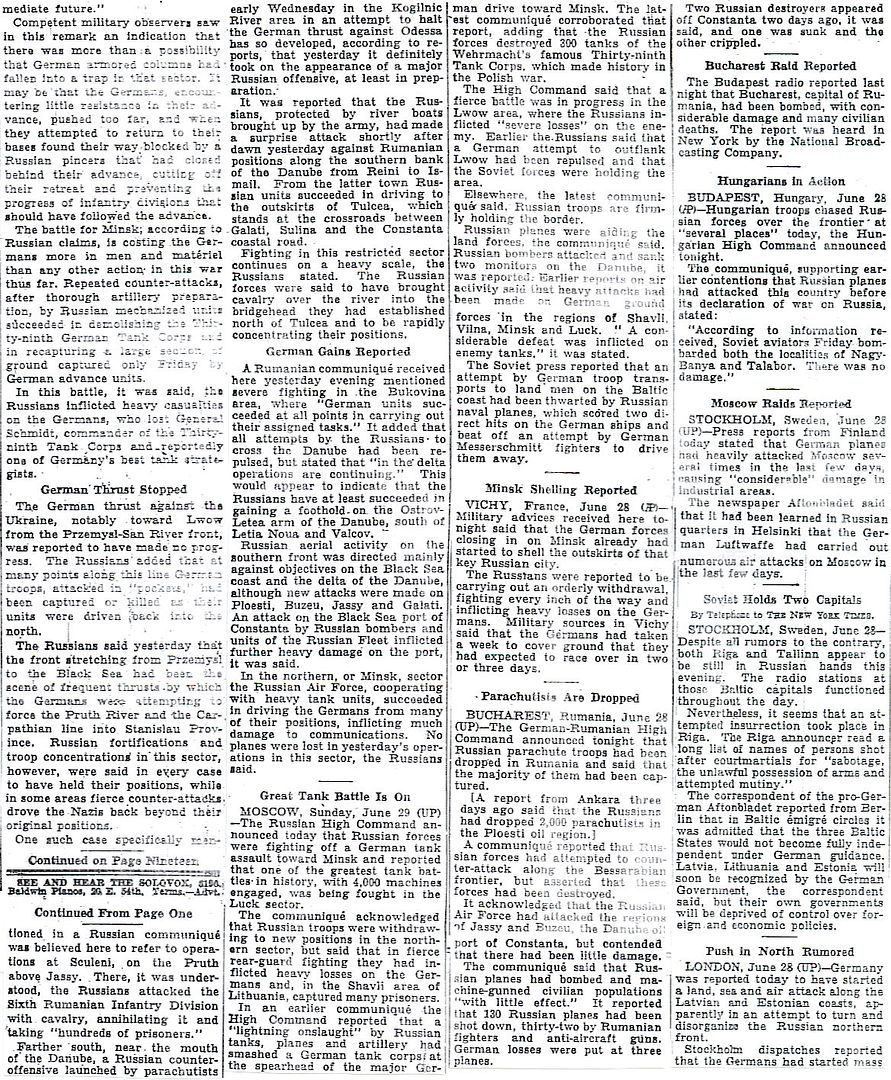
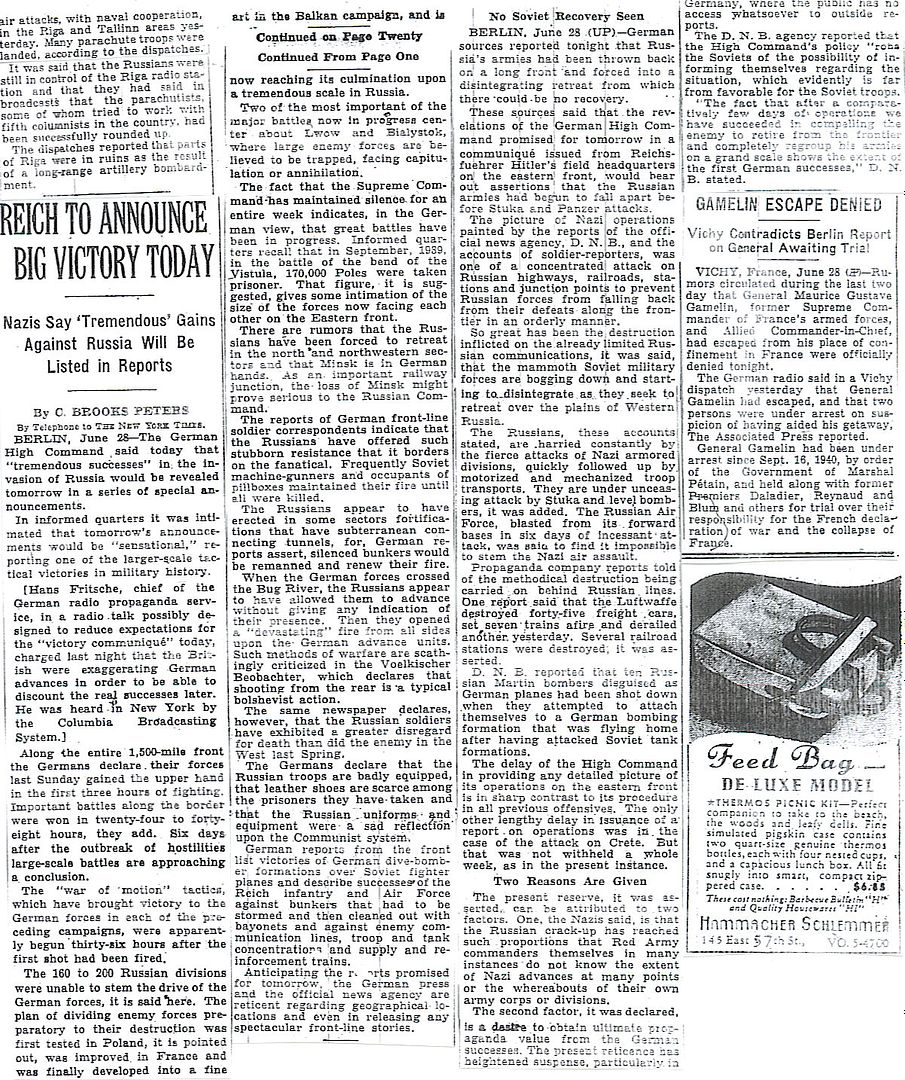
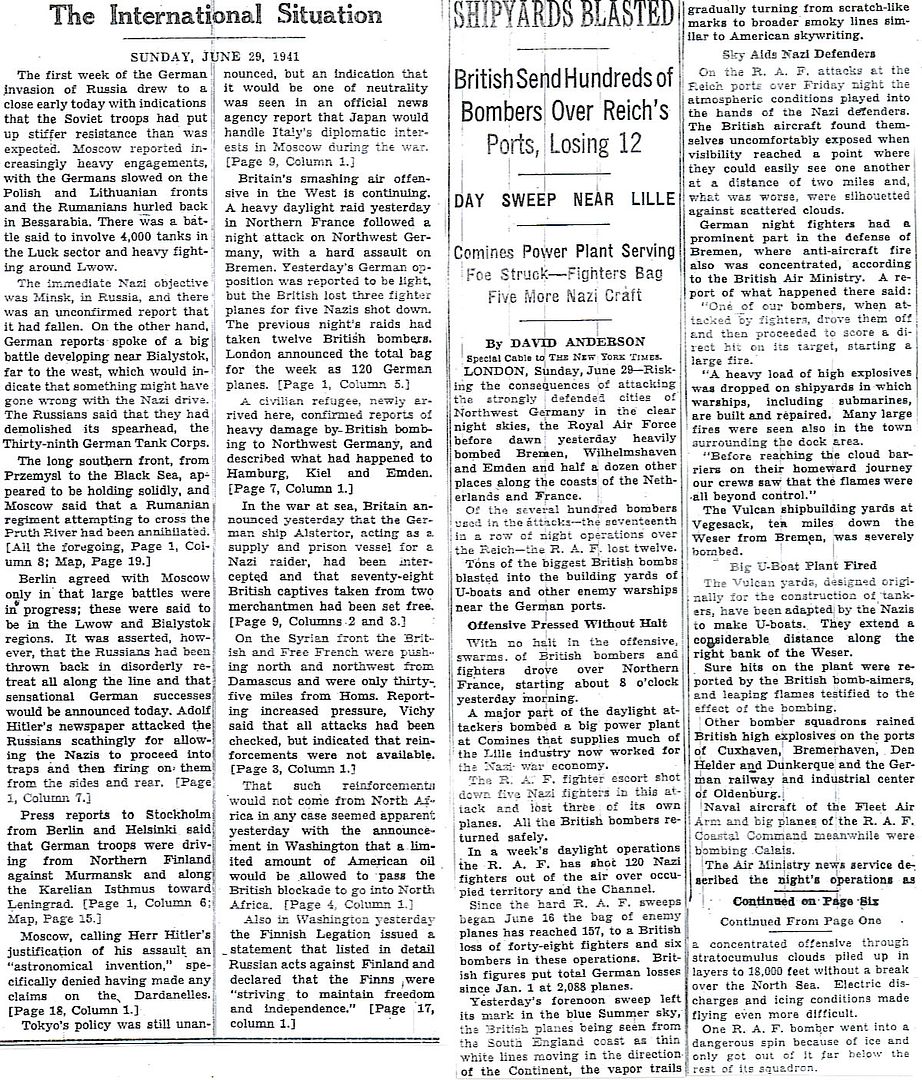


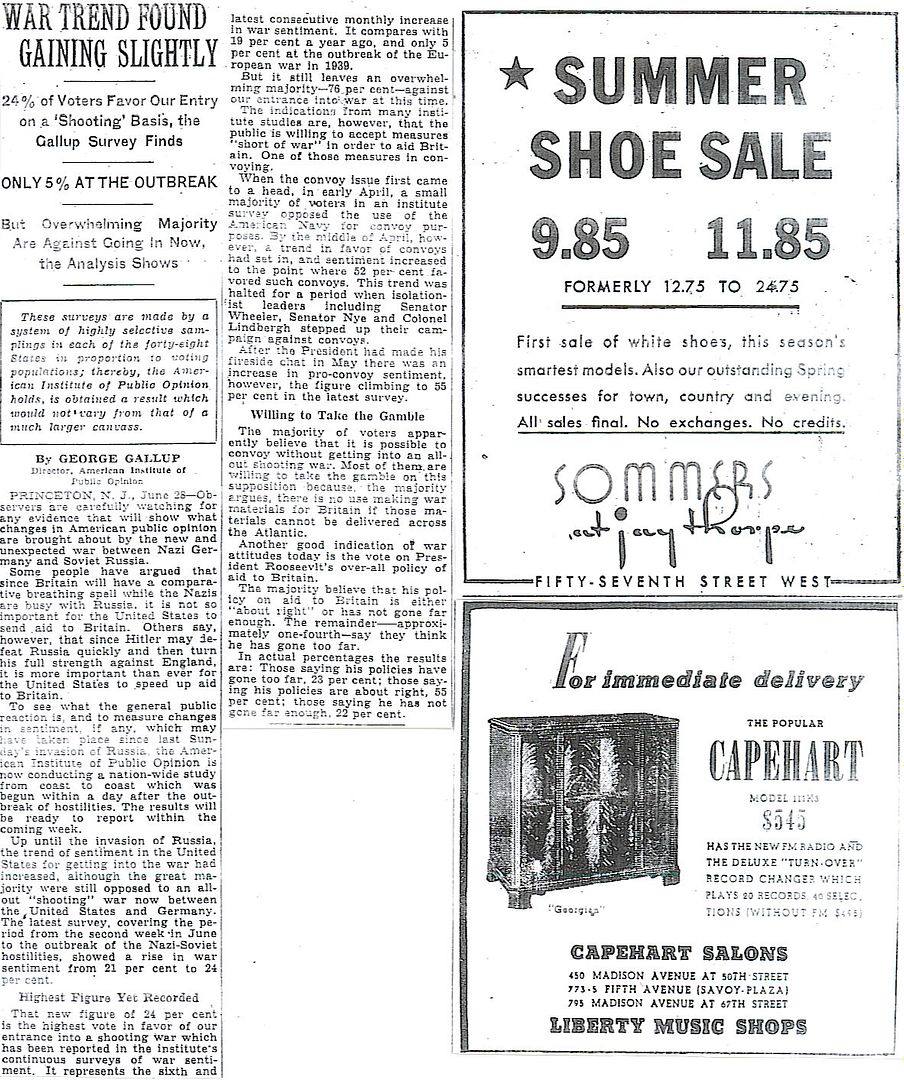
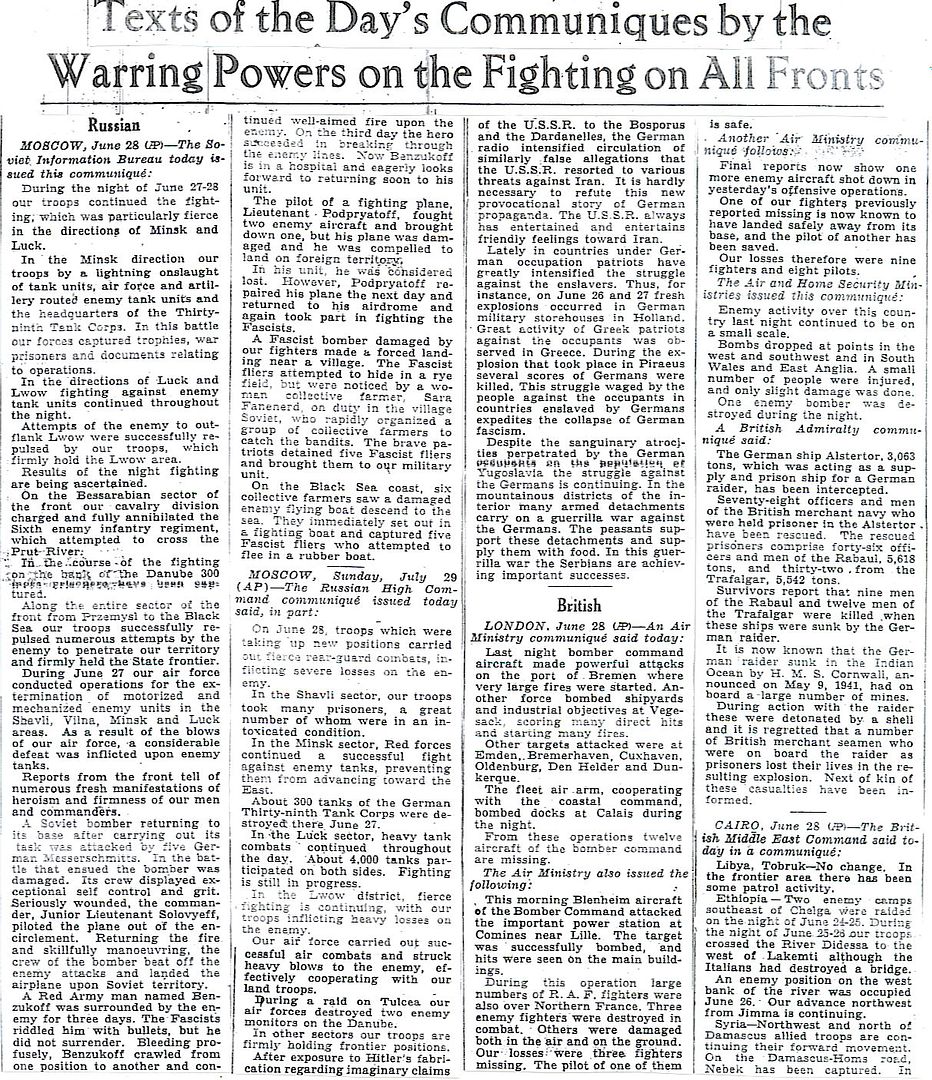
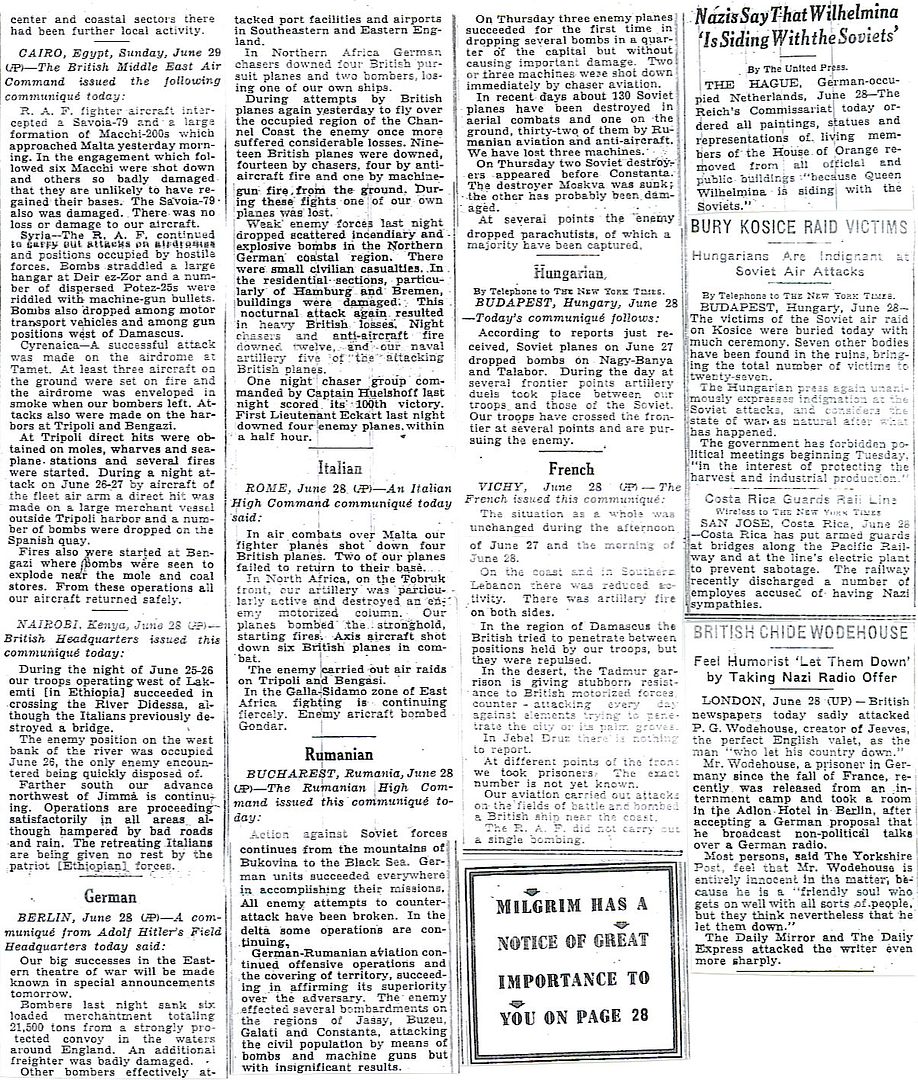

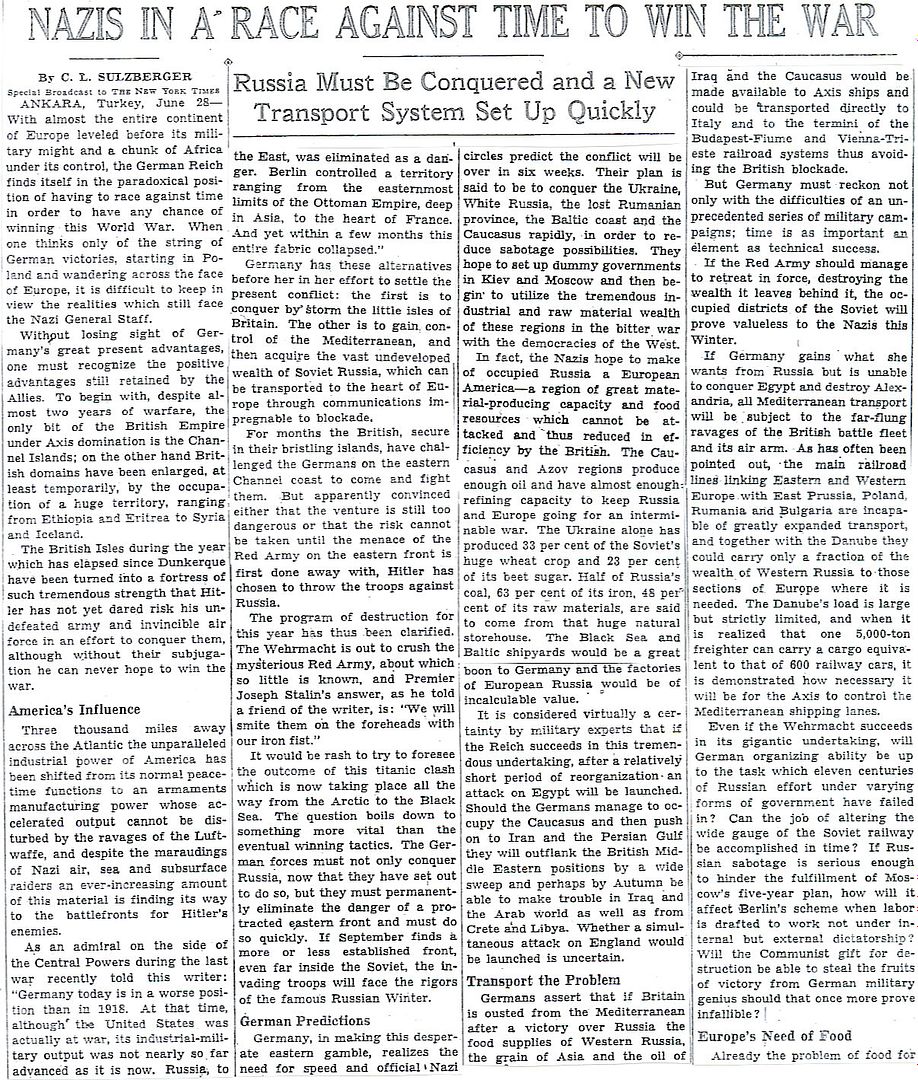
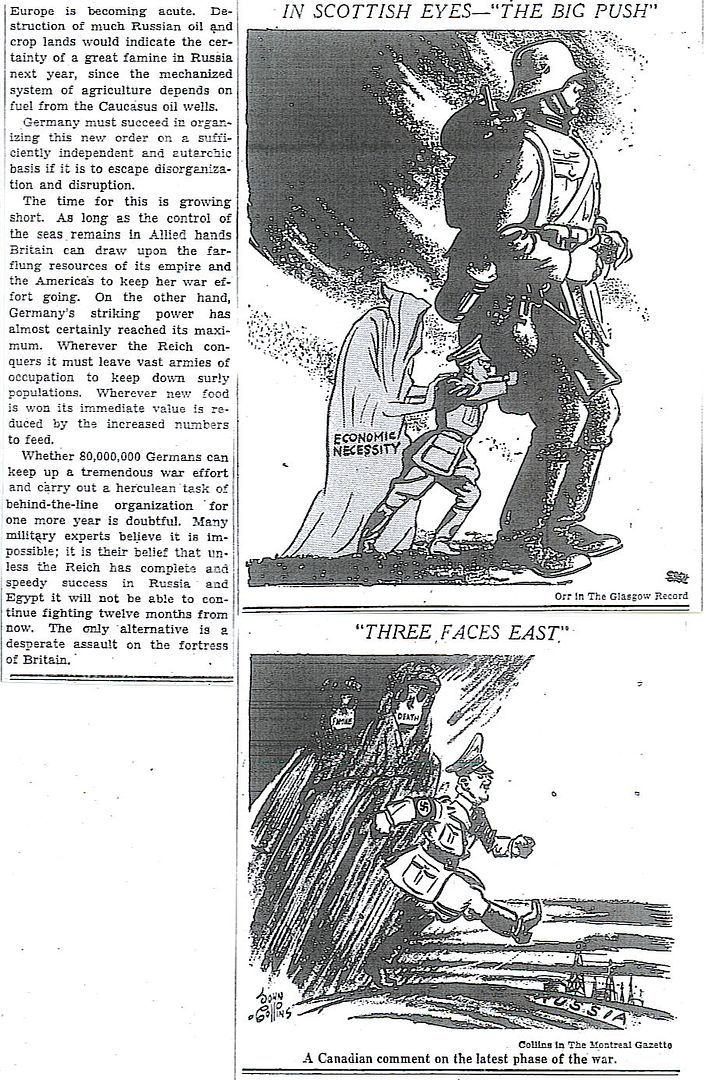
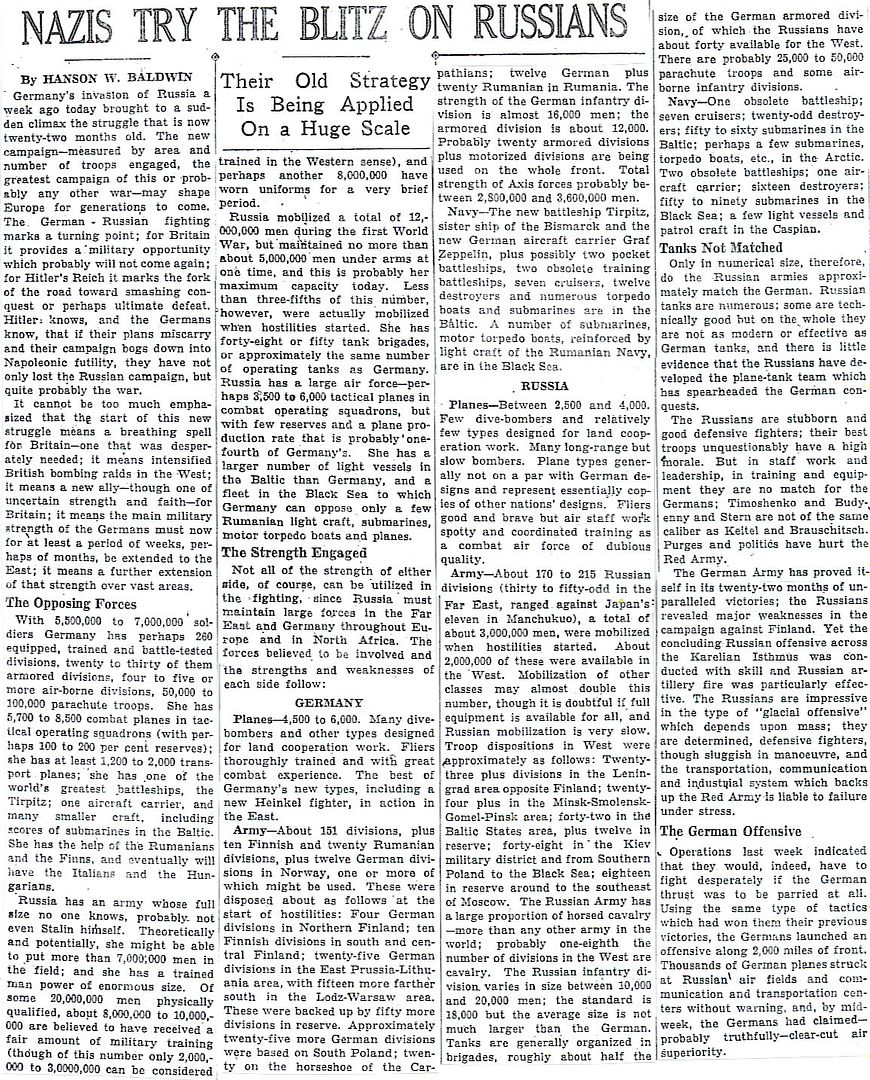
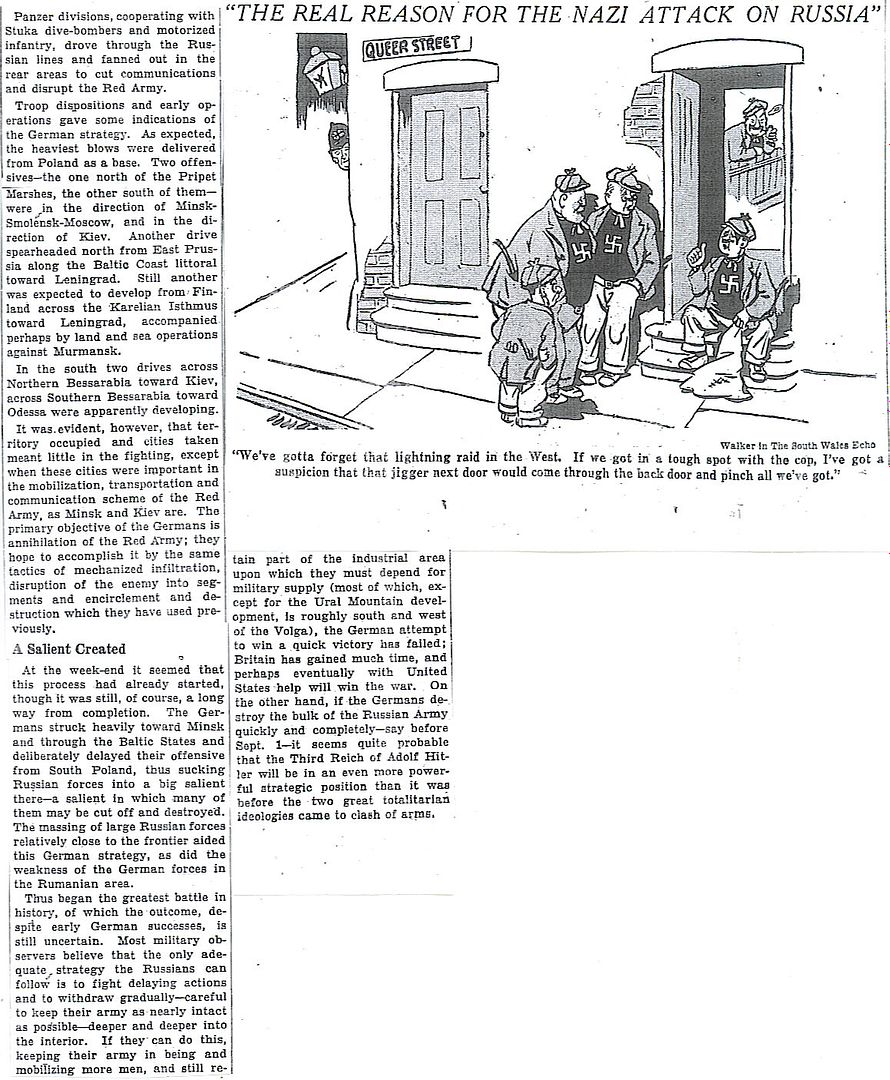
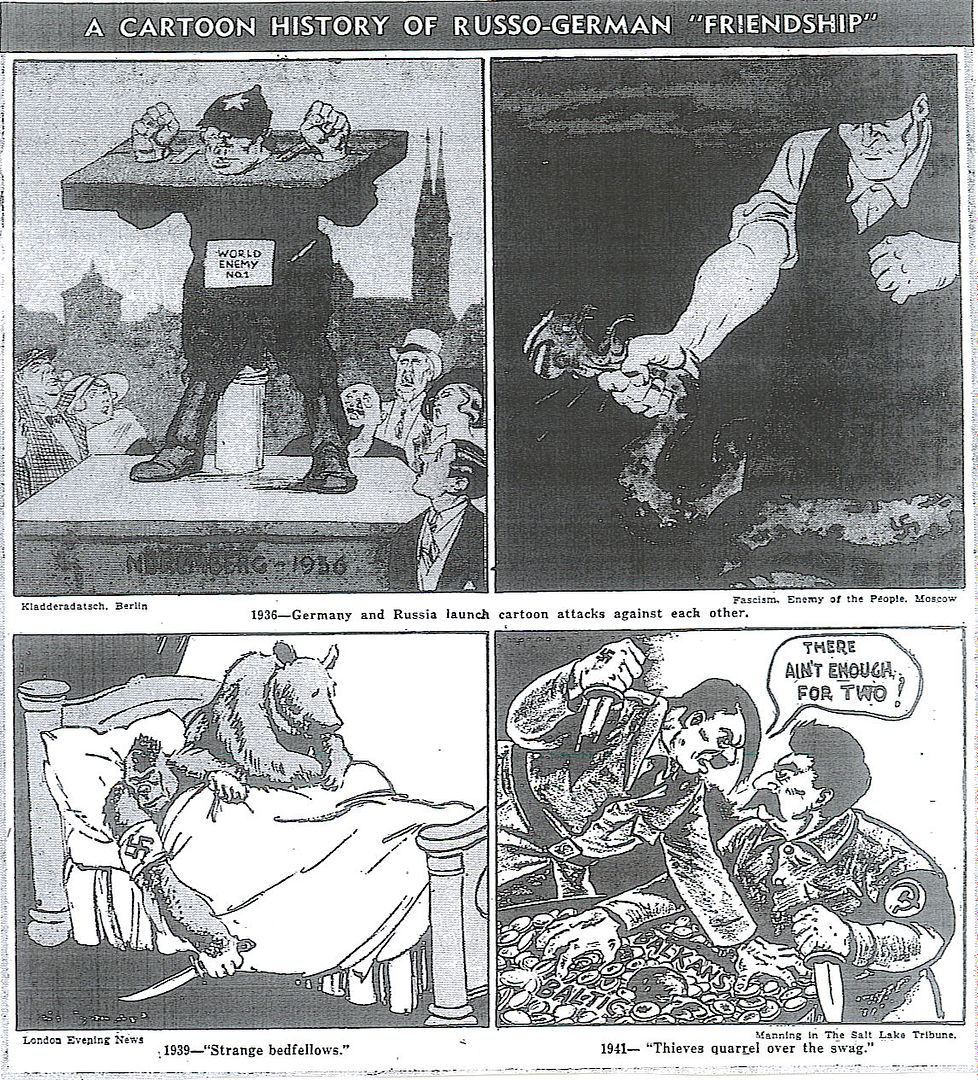
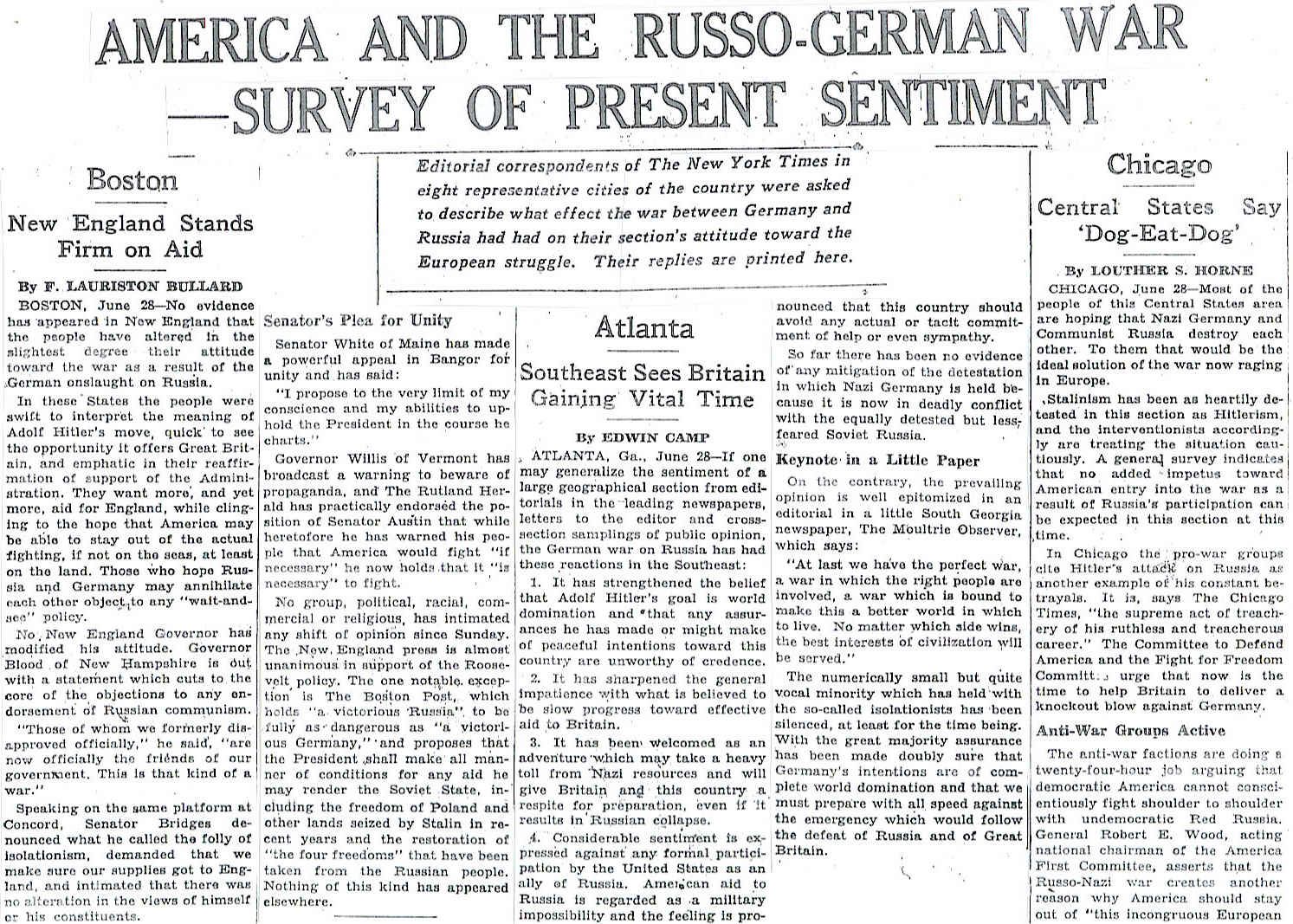

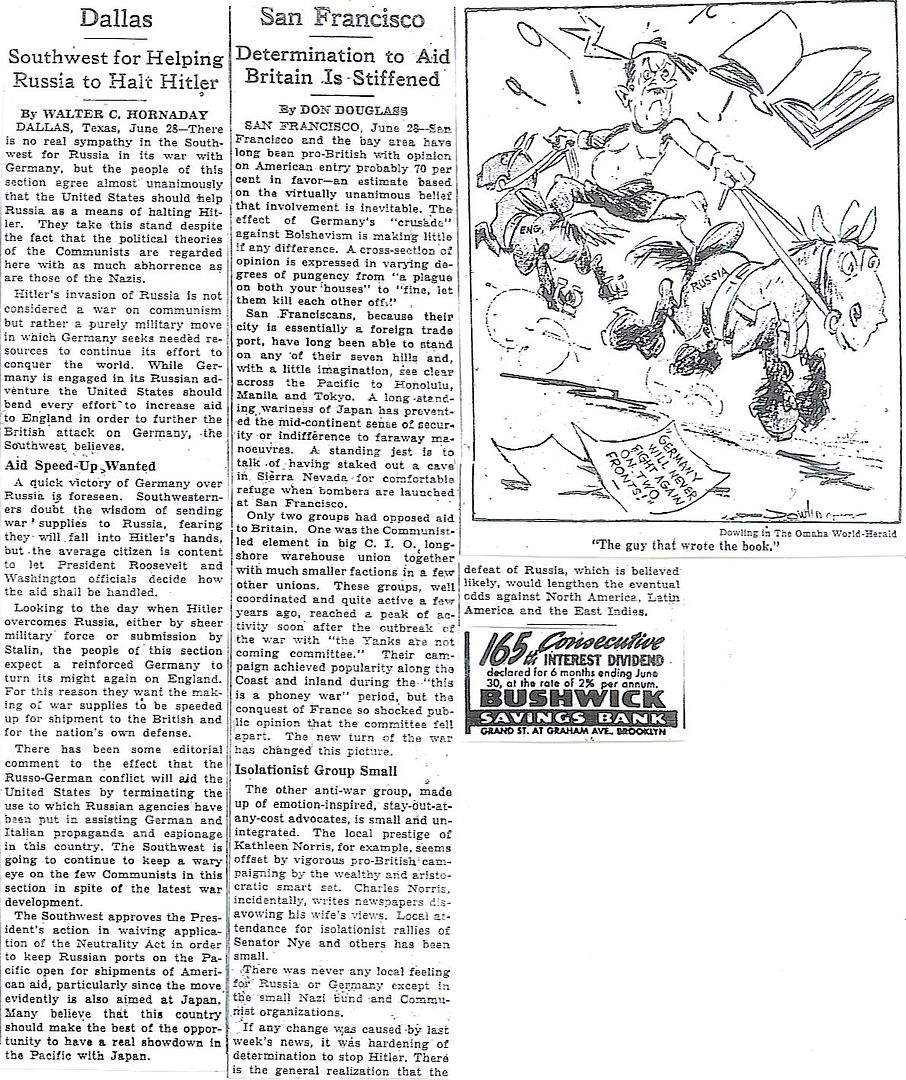
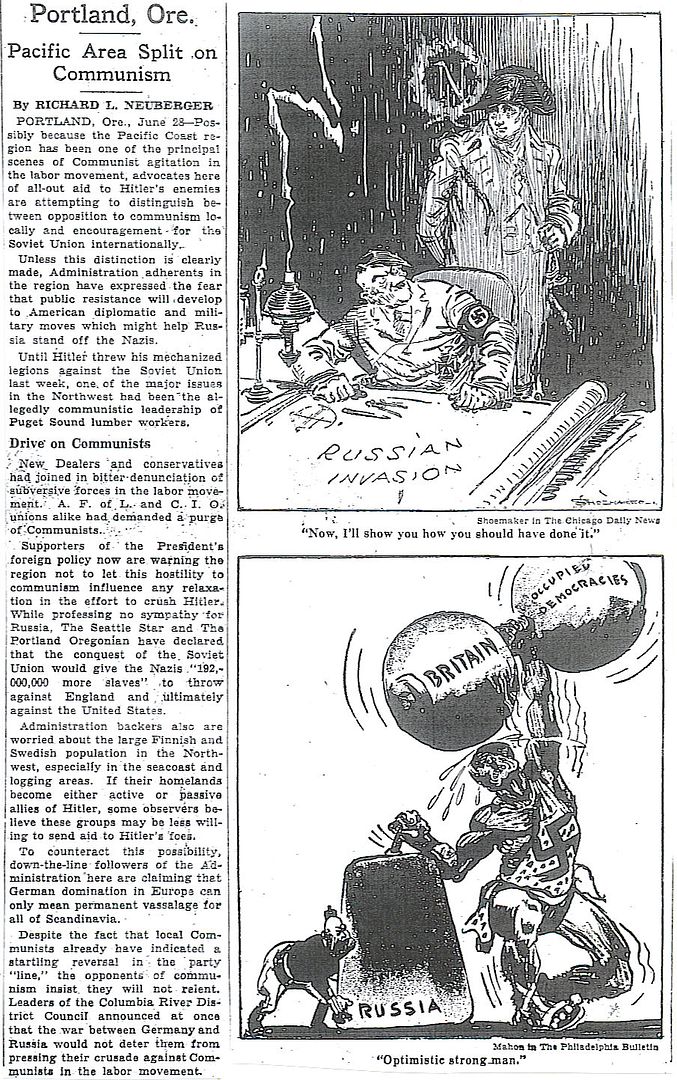


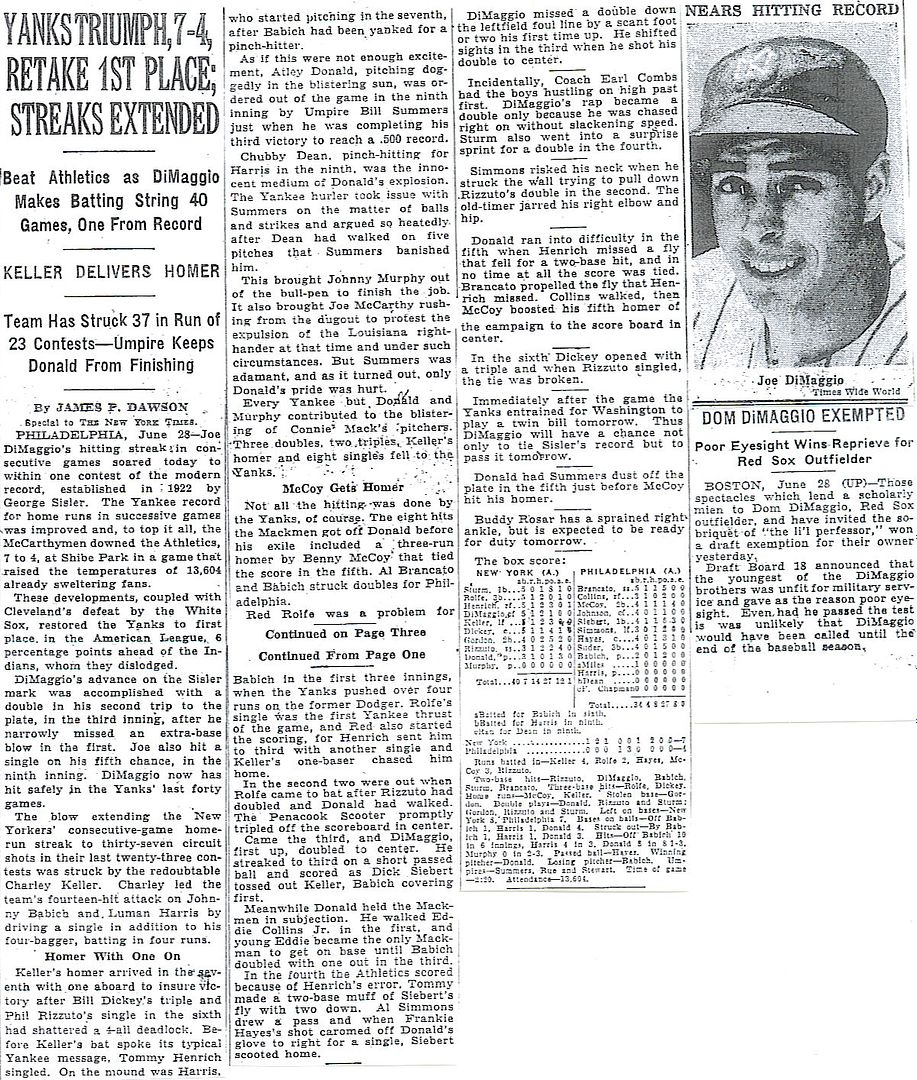
The News of the Week in Review
Twenty News Questions – 11
Nazis in a Race Against Time to Win the War (by C.L. Sulzberger) – 12-13
Nazis Try the Blitz on Russians – 14-15
A Cartoon History of Russo-German “Friendship” – 16
America and the Russo-German War – Survey of Present Sentiment * – 17-22
Answers to Twenty News Questions – 22
Yanks Triumph, 7-4, Retake 1st Place; Streaks Extended (by James P. Dawson) ** – 23
* Try to imagine this whole batch of articles and cartoons on one page, like it was in the original. It is not quite the same the way it is reassembled here.
** Joe DiMaggio’s hitting streak in consecutive games soared today to within one contest of the modern record, established in 1922 by George Sisler
http://www.onwar.com/chrono/1941/jun41/f29jun41.htm
Germans and Finns attack far north
Sunday, June 29, 1941 www.onwar.com
On the Eastern Front... The German armies are maintaining their advances and the Soviet positions is further stretched by the start of joint German-Finnish attacks in the Karelian Isthmus and farther north near Petsamo. Meanwhile, the last Soviet resistance in the Citadel area of Brest-Litovsk is eliminated.
http://homepage.ntlworld.com/andrew.etherington/month/thismonth/29.htm
June 29th, 1941
UNITED KINGDOM: A Cabinet reshuffle brings Beaverbrook to the ministry of supply.
Destroyer HMS Croome commissioned. (Dave Shirlaw)
FRANCE: VICHY FRANCE: The French Government announced in a communiqué:
The British Fleet has bombed our coastal positions in the Middle East. We have evacuated several of our bases in the mountains of southern Lebanon under cover of artillery fire which inflicted heavy losses on our assailants. Out aerial forces, supported by naval aircraft, repeatedly intervened in the ground fighting, especially around Palmyra (Syria). A British colonel and 40 men were captured.
FINLAND: This day sees the first fighting in Karelia. Col. Pajari’s 18. Div. is given the assignment to recapture Enso, an industrial town that was just barely left on the Soviet side of the border after the peace-making of the Winter War in 1940.
The Karelian Army (Karjalan Armeija) is formed to operate in northern Karelia. (Mikko Härmeinen)
ROMANIA: Jassy: Local police and militiamen kill 260 Jews in their homes, rounding up 5,000 for deportation in sealed cattle trucks.
U.S.S.R.: Stalin, recovering from the shock of being attacked by his former ally, has put himself at the head of a committee of defence in which the whole power of the state will be concentrated to fight the Nazis. The Red Army, too, is recovering from its initial unpreparedness and its well-armoured, fast T34 tank has given the Germans a nasty surprise. What has really surprised the Germans, however, is the resistance being put up by the ordinary Russian soldiers fighting in the defence of their homeland.
The new Committee of Defence, takes complete control of the country.
The German forces commanded by Hoth and Guderian complete the encirclement near Minsk. The pocket captured includes Gorodische.
EASTERN FRONT: The fortress of Brest-Litovsk falls after a week long seige when it is bombed by Squadrons of Ju88s. Guderian’s Panzer Group links up near Minsk with the Panzers of General Hermann Hoth, creating a huge Soviet pocket.
SYRIA: At Palmyra, French Foreign Legion defenders drive Wiltshire Yeomanry from ridge overlooking the town. Next day it is partly recaptured by 1/Essex. On the coast, Brig Stevens’ policy of holding the main forces of 21 Aust Bde back from the Damour Valley limits the casualties inflicted by French artillery. He maintains pressure on the defenders by vigorous patrolling. (Michael Alexander)
LEBANON: In an effort to kill Gen Dentz, four Blenheims bomb the residency in Beirut. (Michael Alexander)
Beirut: The French Havas News Agency reported:
This afternoon British aircraft bombed and destroyed the residence of the French High Commissioner in Beirut. There were large numbers of dead and wounded.
MEDITERRANEAN SEA: Destroyer HMS Waterhen is attacked by an Italian Ju 87 aircraft in the Mediterranean 100 miles east of Tobruk. She is brought to a standstill; so much of her equipment is taken off in readiness for a tow. However, as flooding had spread from the engine room through to the boiler room it became impossible to effect the tow, and she rolled over and sank. (Alex Gordon and Mike Yaklich)(108)
U.S.A.: The USN’s Task Group 2.8, consisting of the aircraft carrier USS Yorktown (CV-5), heavy cruisers USS Quincy (CA-39) and USS Vincennes (CA-44) and four destroyers, departs Hampton Roads, Virginia, for neutrality patrol.
The Yorktown Air Group consists of Fighting Squadron Forty Two (VF-42), Scouting Squadron Forty Two (VS-42), Marine Observation Squadron One (VMO-1) and half of Marine Scouting Squadron One (VMS-1). USS Yorktown and two destroyers return to Hampton Roads on 12 July while the two cruisers and two destroyers continue on to Bermuda arriving on 15 July. (Jack McKillop)
In baseball, the Washington Senators host the New York Yankees in a doubleheader at Griffith Stadium in Washington, D.C. In the first game, Yankee star Joe DiMaggio gets a double off Senator’s pitcher Dutch Leonard extending his hitting streak to 41-games and tying George Sisler’s modern-day major league record set in 1922. Between games, DiMaggio’s bat, a 36-ounce (1.02 kg), 36-inch (91.4 cm) Louisville Slugger with an ink mark on the bottom of the knob, is stolen. He goes hitless in three attempts in the second game, then remembers that he had loaned Yankee right fielder Tommy Henrich one of his bats earlier in the year. Henrich gives it to him, and he singles off Red Anderson in the seventh inning extending his streak to 42-games. “I’m glad a real hitter broke it,” said Sisler of his record. (Jack McKillop)
Polish statesman, pianist and composer Ignace Jan Paderewski dies in New York City at age 80. Upon receiving word of Paderewski’s death, President Franklin D. Roosevelt called the U.S. State Department and asked that the department inform Paderewski’s family and officials of the Polish embassy that Paderewski’s body could be given a temporary resting place in the vault of the Mast of the USS Maine Monument in Arlington National Cemetery.
President Roosevelt said, “He may lie there until Poland is free.” On 26 June 1992, Paderewski’s remains were moved from the USS Maine Memorial and were flown to Warsaw by the U.S. Air Force. (Jack McKillop)
CANADA: Corvette HMCS Kenogami commissioned. (Dave Shirlaw)
ATLANTIC OCEAN: Another U-boat has been sunk by the escort of convoy HX-133, which has been harried by German submarines for most of the past week. The “wolfpack”, originally consisted of ten U-boats, has sunk five ships of the convoy despite a strong destroyer escort including the Canadian destroyer “Ottawa”. The pack struck first on 23 June, sinking one merchantman. Four more ships have been lost since, although the Canadians with their Asdic equipment and depth charges have so far replied by sinking three U-boats. Today, destroyers Scimitar and Malcolm, corvettes Arabis and Violet and minesweeper Speedwell sink U-651 (Type VIIC) with depth charges south of Iceland at 59.52N, 18.36W. All 45 U-boat crew survive. The escort had been reinforced to a total of 13 ships as a result of ‘Ultra’ intercepts. This is the first of the big convoy battles and leads to the development of additional support groups.
U-69 departed Las Palmas de Gran Canaria harbour in the early hours of the morning having secretly refuelled from the interned German supply ship Charlotte Schliemann.
At 0051, U-103 hit a steamer of 6600 tons with its last torpedo in the engine room that sank by the stern after 21 minutes about 450 miles west of Las Palmas. The ship had been spotted at 1642 the day before and was missed by a stern torpedo at 2328. After the sinking, Schütze questioned some survivors but he did not believe them when they told him that they were from the Italian steamer Ernani en route from Las Palmas to Horta, because the course of the ship did not correspond with the mentioned route. In fact, the U-boat had sunk the Italian blockade-runner Ernani, disguised as the Dutch steam merchant Enggano. Schütze was not blamed for his mistake because he was not informed about the presence of an own vessel in the area.
At 1936, the Rio Azul in Convoy SL-78 was hit near the bridge by one stern torpedo from U-123 about 200 miles SE of the Azores. Hardegen assumed that the ship was a Q-ship but this was not the case. She broke in two and sank in a short time. The master, 31 crewmembers and one gunner were lost. Six crewmembers and three gunners were picked up by HMS Esperance Bay and landed at Scapa Flow, Orkneys.
At 1958, the unescorted Hekla was torpedoed by U-564 and sank within two minutes. Seven men survived the sinking and spent 10 days on a life raft before they were picked up by HMS Candytuft that was being employed as a scout before a westbound convoy. One man died the next night onboard the corvette. The surviving 6 men were taken to St John’s, Newfoundland. One of the men spent over 6 months in a hospital before going back to Iceland.
At 0030, U-651 attacked the convoy HX-133 south of Iceland and sank the Grayburn. Later that day, the U-boat was sunk by the escort vessels from this convoy. The master John William Sygrove and 16 survivors from the Grayburn were picked up by corvette HMS Violet and transferred to the British rescue ship Zaafaran. Later they were transferred to the British armed trawler HMS Northern Wave and landed at Gourock. Another survivor was rescued by corvette HMS Arabis and landed at Londonderry. 27 crewmembers and 8 gunners were lost.
U-66 attacked Convoy SL-78 and sank SS George J. Goulandris and the straggler Kalypso Vergotti. (Dave Shirlaw)
CL Sulzberger had a very good article on the Germans’ gamble on having the war over before the Russian Winter, and how the Germans were in an even more precarious position here than they were in World War I. Also, the cartoon of Stalin telling the Communist saboteur in the West to “Stopski” explains why America was so united for World War II- most Americans wanted to preserve democracy and defeat totalitarianism, while the American Left had to follow their Moscow handlers’ dictates and keep America producing weapons and materiel, so their hero-nation wouldn’t be defeated.
>>> The USN’s Task Group 2.8, consisting of the aircraft carrier USS Yorktown (CV-5), heavy cruisers USS Quincy (CA-39) and USS Vincennes (CA-44) and four destroyers, departs Hampton Roads
Doomed task force. Yorktown lost at Midway of course, and Quincy and Vincennes both sunk at Savo.
A damn near run thing, that.
Best,
Chris
bmp
Notice how fast the Socialists in America have become War HAwks, now that the Soviet Union has been attacked?
In the early hours of 29th June the U Boat U 651 got inside a convoy and torpedoed the merchant vessel SS Grayburn. U-651 was on her first operational mission and this may account for why minutes later she was in collision with one of the other merchant vessels in the convoy.
The convoy escort warships were on to her almost immediately and she was subjected to a pattern of depth charging, although she went deep, she sustained further damage from these. She was forced to the surface at about 0730 and when she started up her diesels, causing a certain amount of black smoke, she was spotted and subjected to shell fire by the escorts. The crew abandoned the U-boat and all were captured.
As usual Royal Navy Intelligence took care to interview all the prisoners, learning as much as they could about everything related to U Boat operations, from technical developments to the conditions in their home ports. They also gathered information about the morale and attitude of the crew. U-651 were considered to be particularly fervent Nazi’s.
The First Lieutenant, Oberleutnant zur See Karl Josef Heinrich, was an extremely unpleasant person, uncouth and ill-informed, and made every effort to be a general nuisance, both he and the Engineer Officer (Engineer Lieutenant) Benno Brandt, believed that they were furthering the cause of Hitler’s New Order by making innumerable minor complaints and by attempting to bully sentries and others who were unfortunate enough to have to come into contact with them.
These officers were not of the officer class, and only slightly educated. They felt insulted when asked their religion, Heinrich stating the he had no time for “all that tomfoolery,” but adding later he was vaguely a “God-believer”.
Brandt professed to be a German-believer, which he thought a still more advanced state of mind, immeasurably superior to the possession of a faith in God, who after all, had started life as the “Jewish Jehovah.” This officer was considered by everyone who came in contact with him to be the worst specimen of a prisoner encountered in this war.
U 651 carried three Midshipmen whose suitability for U-Boats was being tested, they were Fahnrich zur See (Midshipmen) Gustav Adolf Schutze, Georg Sturenberg and Wilhelm Schneider.
They were scarcely of the Officer class, had been educated in the Nazi creed from the age of about twelve or thirteen and were consequently almost illiterate, and lacking any personality whatsoever, they had no knowledge of history, and not even a smattering of English or French, they gave the impression of only having learnt a little reading and less writing.
Their conversation consisted of propaganda quotations which they did not fully understand, and which they frequently introduced in the wrong place. They had apparently had very little home-life or parental influence, and later, only inadequate naval training, they did not even know how to stand to attention, nor how to address a superior officer.
The deterioration since the beginning of the war in the type of U-Boat officer was more marked in the case of U 651 than in any batch of naval prisoners recently examined.
Global Warming from 70 years ago!
ML/NJ
Battle of Werba
29th June 1941
In late June the Soviet 8th Mechanized Corps lunched an attack northwards towards Dubno, aiming to cut through a deep penetration in their lines by the 11 and 16 Panzer Divisions
Initially the attack was fairly successful with the 34th Tank Division supported by the 24th Tank Regiment of the 12th Tank Division reaching the outskirts of Drubno on the 27th of June. The Germans had to scrape together a wide assortment of rear area troops too keep them out of the city.
On the 28th of June the first battle was fought at Werba on the 34th Division’s flank. The Soviets launched an attack on the German panzers in the town. It was highly successful and the defenders broke an ran leaving several abandoned tanks behind them. (The identity of the unit that broke is unclear. it was most certainly part of 16 Panzer Divsion, it was likely the I/2 Panzer Regiment)
Werba controlled the vital road and rail links north to Dubno, ownership of the town pretty much cut off the supply route to the 34th tank Division to the north around Dubno. To make up for the previous day’s debacle the 16 PD re-took Werba early on the 29th, and then regrouped to take the dominating heights above the town.
The Germans failed in their attack up the hill. The fire from the Soviet tanks was enough to compel the Germans to retreat towards Werba. However the counter attack by the Soviets out of Ptytscha was not strong enough to dislodge the Germans from Werba. the last Soviet tanks, including a T-35 succumbing to German fire on the outskirts.
Tactically the battle was a draw but the 34th Tank Division remained cut off to the North so operationally it was a German victory

The Iasi Train Of Death:
About 8 p.m. on Sunday, June 29, 1941, the 2,500 or so Jews who had survived the Iasi pogrom and were being held at the police station were transferred to the train station. Various accounts estimated 2,430-2,590 prisoners were herded into 33-39 windowless cars, with about 80-200 Jews in each. Ioanid uses the figure of 2,530.
Originally the “deportees” were to be sent to Tirgu Frumos; then Calarasi (Kalarash) was chosen. But that was just the beginning of the contradictory changes.
The first train left Iasi between 3:30 and 4:15 a.m. on the 30th; at 7:30 a.m. it passed Tirgu Frumos (40 km from Iasi), went to Pascani, Lespezi, returned to Pascani, then went to Roman, and stayed there from 11:45 a.m. to 4:00 p.m., at which time it went to Tirgu Frumos again, arriving at 9:30 p.m.
The doors to the packed boxcars had been closed the entire time, and the prisoners had had no food or drink the entire trip. The conditions on the trip and the removal of the dead are described in horrifying detail in Ioanid’s book. The living in the last boxcar were allowed to disembark — barely 200 survivors of the 17-hour death train-and moved to a synagogue, where they were subjected to other tortures.
On July 1 Iasi gendarmes took charge and emptied the corpses and at approximately 4:00 p.m. the death train resumed its journey to Calarasi. The train stopped at Mircesti, 40 kms from Tîrgu Frumos, the next morning, where 327 corpses were unloaded. On July 3 the train passed through Sabaoani, 10m kms away, and then went to Roman, where it was not allowed to stop because of the smell.
Finally the train returned to Roman, where 53 more corpses were removed. On July 4-5 the train was at Marasesti (120 kms from Roman), where 10 additional dead bodies were removed. The next night, 40 more were removed at Inotesti. Finally at Ploiesti the surviving prisoners were give bread and water. On July 6, the train arrived at Calarasi, with 1,076 survivors, 69 close to death, and 25 more corpses.
The 500 km journey over a period of 6 1/2 days in excruciating heat, mostly without water, for the prisoners had yielded 1,400 fatalities.
The invasion began on June 22. By the 23rd (See image #10) the Reds had changed position so fast they probably all got whiplash.
(DiMaggio streak update at #23 of today's post.)
1st Mountain Division, following behind the SS Viking Motorized Division, occupies Lemberg late in the evening on June 29th/30th.
When they occupy the two local prisons, they find over 4,000 dead bodies, murdered by the NKVD and the GRU as they retreated.
The intelligence section of the 49th Army Corps observed in its first report, dated that same day: “According to the account of Major Heinz, commander of a battalion of Regiment 800, thousands of brutally murdered persons were found in the Lvov prisons. The 1st and 4th Mountain Divisions are hereby ordered to assign journalists and photographers to cover these atrocities.
The chief military judge of the Corps and the liaison officer of the Foreign Office with the High Command of the 17th Army have been sent to Lvov to carry out in-depth investigations.”
Wilke, chief judge of the 49th Army Corps, issued a report dated 1 July 1941: “The examination of the bodies found at the OGPU prison indicated that the killings had been preceded by torture.... The majority of the victims are Ukrainians; the rest are Polish. Witnesses also reported that in this prison two German wounded pilots had been interned. A Luftwaffe belt and a pilot’s cap were found in the prison. In ... one of the mass graves a Luftwaffe helmet was also found. Thus it must be assumed that these German airmen are among the bodies that could not be identified.” Judge Wilke remained in Lvov until 6 July and took the sworn depositions of numerous witnesses, including those of senior medical officer Dr. Richard Eckl, veterinarian Dr. Joseph Brachetka, and noncommissioned officer Kurt Dittrich.
Further witness depositions, including those of Polish and Ukrainian detainees who had survived the liquidations at the prisons, were obtained by Judge Möller, on special assignment to the High Command of the 17th Army. On 6 July 1941 Möller took the deposition of Dr. Saeltzer, who had accompanied Tomforde to the prisons on 30 June 1941:
The Brygidky prison ... was still burning. There I met a young Ukrainian, aged about 24 years.... He claimed that 24 hours before, shortly before he was to be executed, he had succeeded in escaping from cell 3 of the left wing; he guided me through the cellars, the ground floor, and the first floor of the prison. The people who rushed in through the main entrance wailed and lamented while asking to see their relatives, with whom they had been in contact two days before by shouting from outside the prison. We discovered ... in the first four cellars a considerable number of bodies, the upper layer being relatively fresh and the lower layers in the pile already in advanced decomposition. In the fourth cellar the bodies were covered by a thin layer of sand. In the first courtyard we found several stretchers stained with blood. On one of the stretchers I saw the body of a male who had been killed by a bullet through the back of the head.... I ordered that the cellars should be immediately cleared, and in the course of the next three days 423 corpses were brought out to the courtyard for identification. Among the bodies there were young boys aged 10, 12, and 14 and young women aged 18, 20, and 22, besides old men and women....
From there I continued to the former OGPU prison.... We broke the door leading to the lower prison rooms and saw there 4 corpses at the foot of the stairway, among them a young woman aged about 20 years, who apparently was shot at the very last minute; in the first large room the corpses were piled up to about half the height of the room.... In the courtyard were two mounds of earth from which parts of corpses stuck out. There too the recovery of the corpses was immediately begun, and they were carried to the main courtyard.... In the second courtyard of the OGPU prison I found at one of the gates a Luftwaffe cap and a parachute belt....
[At] the military prison in the northern part of the town ... the stench of decomposition was so strong and there was so much blood under the mountains of corpses that we had to wear a Polish gas mask in order to enter the cellar and carry out the necessary investigations. Young women, men and older women were piled up layer upon layer all the way to the ceiling.... The third and fourth cellars were only about three-fourths full. Over 460 corpses were taken out of these cellars. Many of the bodies showed evidence of serious torture, mutilations of arms and legs, and shackling. The recovery of the remaining bodies was stopped upon orders of the commander because as a consequence of the heat the decomposition of the bodies was already advanced, and there was no possibility of identifying the scantily dressed corpses.
At the military hospital the bodies of three members of the Luftwaffe were found. Judge Möller ordered a medico-legal autopsy to determine the cause of death, and the pathologist of the 17th Army, Dr. Herbert Siegmund, was entrusted with the task. The corpses of four other German airmen found at the OGPU prison were also subjected to forensic investigation. On 3 July 1941 Judge Möller took a deposition from Dr. Siegmund, who explained that the first three soldiers had been shot dead in their hospital beds:
The body lying on the left bed next to the window had a superficial skin wound on the right chest, the size of the palm of my hand. The wound was several days old and had been freshly dressed. Moreover, there was a more recent bullet wound inflicted by a 6.5-mm bullet through the skull slightly over the left ear; the exit wound was about one centimeter in diameter through the right temple, which was considerably destroyed.... The body on the middle bed had a broken jaw that had been professionally bandaged ... the examination also established a fresh bullet wound on the left chest, fourth centimeters down from the nipple, in the area of the heart. The body on the third bed next to the wall had a large wound in the under side of the lower leg ... a fresh bullet wound of the same caliber as that seen in the other corpses had been inflicted on the right side of the victim’s stomach, some six centimeters under the costal arch.
Examination of the four other fliers’ bodies indicated that they had not been previously wounded. Three had been killed by a shot through the head; the fourth had no head injuries, but the rest of the body was in such an advanced state of decomposition that an autopsy was not deemed feasible.
Disclaimer: Opinions posted on Free Republic are those of the individual posters and do not necessarily represent the opinion of Free Republic or its management. All materials posted herein are protected by copyright law and the exemption for fair use of copyrighted works.